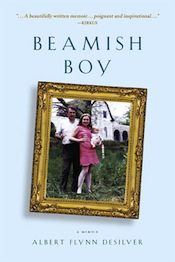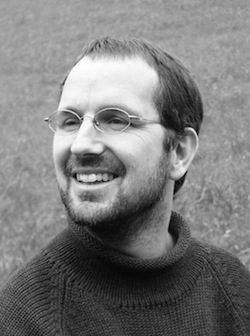
The story of an artist’s search for identity, Beamish Boy opens with that classic trinity of WASP dysfunction: old money, alcohol abuse, and remote parents. The author’s earliest memories conjure a grotesque modern fairy tale of growing up in a large, dark, and creepy Connecticut house, remodeled by a father with failed architectural aspirations into a sort of gothic castle. It’s all there—clock tower, bats, mice, dust, and separate wings of rooms for children governed by the very stereotype of an evil German nanny (dubbed “Das Hell Frau” by DeSilver). The clock, of course, is broken. As are the parents.
DeSilver’s father (who nicknamed him “Beamish Boy” from Lewis Carroll’s “Jabberwocky”) saw his own father die in a subway accident on their way to a Harvard/Yale football game. A few years later, his step-father was murdered in an apparent mob hit. Profoundly distant and sad, he hovers in the shadows except for the few occasions when, overtaken by rage, he looms terrifyingly large. In contrast, Mother is front-row-and-center at all times, and—much as the author says happened in life—she steals the scene every time she appears on the page. A prodigious drinker and pretentious social climber, she is largely oblivious to her children and their needs. But she is also funny, smart, and vivid, and some of the book’s strongest moments occur when DeSilver allows her to speak, uncensored, in her own remarkable voice. Here, diction mingles longshoreman with would-be debutante (a dichotomy sometimes paralleled in the voice of the author) to reflect a deep contradiction that is never resolved. Perhaps this is why she drinks. And drinks. And drinks. Soon enough, DeSilver drinks too.
As its title suggests, this book is as much a story of alcohol addiction and recovery as a quest for artistic identity, and the two often intersect. The narrative turns on several pivotal events, and readers expecting Freytag’s plot pyramid might be surprised by what amounts to a cadence of epiphanies. The first comes when, after decades of self-destructive binge drinking, DeSilver quits. Not, as you might expect, after an accident horrifically reminiscent of the one that killed his grandfather, but instead after a debauch of such spectacular proportions that DeSilver is finally shaken enough to seek help. Sobriety is a revelation, but only the first step on the path to self-realization and recovery. A second crucial step is taken when DeSilver begins to take photographs and make art, discovering in himself a well of creative potential in place of the void he’d assumed existed there. It begins to occur to him that he is more than the sum of his genes and upbringing and that he has the power to construct the narrative of his own life.

Other adventures—ones that perhaps could only have taken place in California in the seventies and eighties—ensue. Many are hilariously described, like the “amoebic plaid fractals” and “butterfly paisley chunks of stew meat and dizziness” induced by psychedelic mushrooms eaten at one Wiccan-like desert retreat. Eventually, the author renounces all addictions but one: pursuit of art. A reading by local luminaries like Diane di Prima, Michael McClure and others introduces him to Bay Area poetry and its vibrant open-mic scene, and DeSilver realizes he has found his métier. He begins to write, “[e]ach new poem . . . like a new piece of self, imprinted on the world,” and discovers “in writing poems a mysterious simplicity, a natural rhythmic immediacy, like writing on water, or talking to God.”
Even in the ardent pursuit of his found vocation, though, DeSilver remains tormented by self-doubt, and he struggles for the kind of spiritual integration that will allow him to transcend petty concerns about publishing and conventional ideas of success. A retreat at the Sinkyone Wilderness in northern California brings him face-to-face with the ruin of his past in the form of a massive decaying elk carcass that he visits each day. During the retreat, alone and sober for the first time in his life, he spends days hiking wilderness trails, reading Lorca, meditating, and constructing his own verse. “[O]ne day at Sinkyone was like a month in my current life,” he says. “I filled my notebooks with a wobbly poetry of grief, regret, death, and rebirth.” Just before he leaves, DeSilver finds himself looking into the eyes of a live elk, intact and majestic, and a powerful symbol of the healing and regeneration he has experienced:
At that moment, my heart burst open, and my vision became incredibly clear. The elk finally wandered into the brush and I kept walking, and my surroundings continued to glow—the ocean rushed into my eyes and receded, the redwoods laughed, the clouds breathed in sync with my lungs, the alder leaves shimmered electric green. . . At that moment, the self I knew as Albert merged into elk and alder, ocean and sky. In that moment I became awake to the immense presence and infinite beauty of this world, and instantly realized, yes, I am that!
Since Beamish Boy is the memoir of a poet well-known in the Bay Area (DeSilver was Marin County’s first Poet Laureate), readers expect lyrical writing, and at times it is powerfully delivered. In one vivid example from his childhood, DeSilver finds a dead bat that, frighteningly, makes a peeping noise. When he turns it over, he sees the baby “clinging ever so tenderly to its dead mother’s breast.” At the end of the book DeSilver returns to this image with the new understanding that the bat was less crying for help than “trying to slip out from his mother’s dead weight and fly off into the dark on his own.” DeSilver varies his prose by weaving in lines of poems by himself and others. I enjoyed reading the author’s vivid, quirky poetry and wish there had been more of it in the book.
The voice occasionally falters when, ostensibly cured of the soul-sickness that has tormented it from the beginning, it speaks with a mocking irony that betrays persistent self-doubt. When DeSilver derides his own early writing, for example, he does not seem to act in the spirit of compassion and integration that the end of the book celebrates. At times I found myself wishing he were able to see himself and his flawed parents with more empathy, but I appreciated the ironic honesty when he acknowledged his own taste for name brands as an apple that fell straight from the maternal tree.
The story is a good one, full of adventure, truth, pain, humor, as well as colorful characters. The chapter titles alone make a good read: “Sunday, Bloody Sunday,” “The Clock Tower,” “East Jesus High School,” “Rocky Mountain Low” and “Open Mic, Closed Throat,” to name a few. Can a person born to wealth and privilege break away from all that to attain real spirituality and make great art? Some would say it is not possible. But in this book, DeSilver aims to prove them wrong, and he does it in a page-turner that will delight anyone who appreciates a good story of addiction and recovery, laced with a stiff shot of literary redemption.




